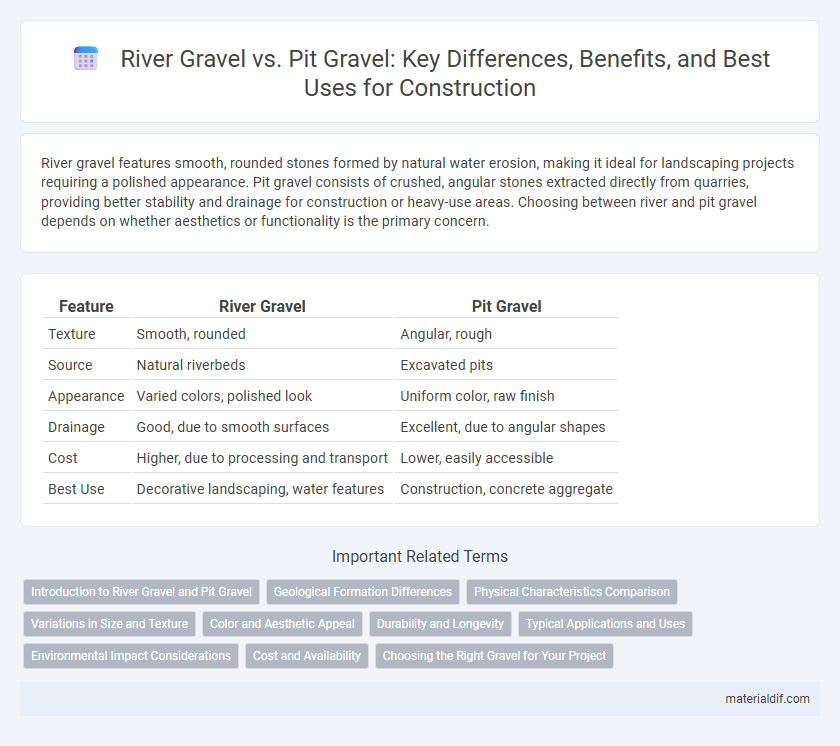River gravel features smooth, rounded stones formed by natural water erosion, making it ideal for landscaping projects requiring a polished appearance. Pit gravel consists of crushed, angular stones extracted directly from quarries, providing better stability and drainage for construction or heavy-use areas. Choosing between river and pit gravel depends on whether aesthetics or functionality is the primary concern.
Table of Comparison
| Feature | River Gravel | Pit Gravel |
|---|---|---|
| Texture | Smooth, rounded | Angular, rough |
| Source | Natural riverbeds | Excavated pits |
| Appearance | Varied colors, polished look | Uniform color, raw finish |
| Drainage | Good, due to smooth surfaces | Excellent, due to angular shapes |
| Cost | Higher, due to processing and transport | Lower, easily accessible |
| Best Use | Decorative landscaping, water features | Construction, concrete aggregate |
Introduction to River Gravel and Pit Gravel
River gravel consists of naturally rounded stones smoothed by water erosion, commonly used for landscaping and drainage due to its aesthetic appeal and uniform size. Pit gravel is extracted from gravel pits where stones are crushed and sorted, resulting in more angular shapes ideal for construction applications requiring strong compaction. Both types offer distinct benefits based on texture and source, influencing their suitability for various projects.
Geological Formation Differences
River gravel forms from the natural weathering and erosion of rocks along riverbeds, resulting in smooth, rounded stones due to constant water flow and abrasion. Pit gravel originates from quarries or gravel pits where rocks are mechanically crushed and screened, producing more angular and irregular shapes. These geological formation differences influence texture, durability, and suitability for construction or landscaping projects.
Physical Characteristics Comparison
River gravel features smooth, rounded edges formed by natural water erosion, resulting in a polished texture ideal for decorative landscaping. Pit gravel, extracted directly from quarries, has more angular and rough surfaces due to minimal weathering, providing superior compaction and stability in construction applications. The distinct physical characteristics influence suitability, with river gravel preferred for aesthetics and pit gravel for structural integrity.
Variations in Size and Texture
River gravel typically features smooth, rounded stones due to natural water erosion, ranging from fine sand-sized particles to larger pebbles and cobbles. Pit gravel, sourced from quarries, often has more angular and rough textures with a wider size variation, including mixed coarse aggregates. These differences in size and texture influence their suitability for landscaping, drainage, and construction applications.
Color and Aesthetic Appeal
River gravel features smooth, rounded stones with a natural variety of colors including soft grays, browns, and muted reds that enhance landscape aesthetics with an organic look. Pit gravel usually consists of angular, crushed stones in more uniform shades such as grays and tans, lending a rugged and industrial appearance. The diverse color palette and polished texture of river gravel make it a popular choice for decorative projects seeking a refined and natural visual appeal.
Durability and Longevity
River gravel, characterized by its smooth, rounded edges, offers moderate durability but can wear down faster under heavy load due to its softer texture. Pit gravel, extracted from crushed rock, exhibits greater hardness and angular surfaces, enhancing its longevity and resistance to weathering and compression. Choosing pit gravel is ideal for high-traffic areas requiring long-term durability, while river gravel suits decorative or light-use applications where aesthetic appeal is prioritized.
Typical Applications and Uses
River gravel is commonly used in landscaping, drainage systems, and decorative purposes due to its smooth, rounded texture and natural aesthetic appeal. Pit gravel, characterized by its angular and rough texture, is preferred for construction applications such as concrete aggregate, road base materials, and foundation backfill because of its superior compaction and interlock properties. Both types serve distinct roles depending on the project requirements, with river gravel favored for visual and erosion control uses and pit gravel optimized for structural support.
Environmental Impact Considerations
River gravel, naturally rounded by water erosion, tends to have a lower environmental impact because its extraction often involves minimal land disturbance and preserves natural habitats. In contrast, pit gravel extraction typically causes significant soil disruption and habitat destruction due to deep excavation processes. Selecting river gravel over pit gravel supports sustainable sourcing by reducing ecosystem disruption and promoting waterway preservation.
Cost and Availability
River gravel generally costs more than pit gravel due to its natural sourcing and smoother texture, which requires minimal processing. Pit gravel is more widely available and economical, as it is extracted directly from quarries and requires less transportation and refinement. Availability of river gravel can be limited by geographic factors and environmental regulations, whereas pit gravel is easier to source in various locations.
Choosing the Right Gravel for Your Project
River gravel features smooth, rounded stones shaped by natural water flow, making it ideal for decorative landscaping and drainage projects due to its aesthetic appeal and excellent water permeability. Pit gravel consists of rough, angular fragments extracted from quarries, providing superior compaction and stability essential for construction bases and concrete mixes. Selecting between river gravel and pit gravel depends on project requirements, balancing visual appeal with functional durability.
River gravel vs pit gravel Infographic

 materialdif.com
materialdif.com